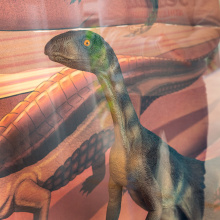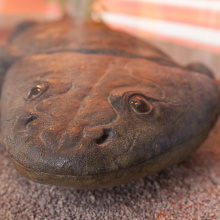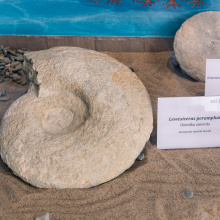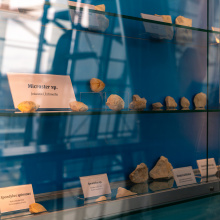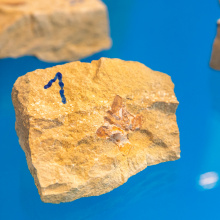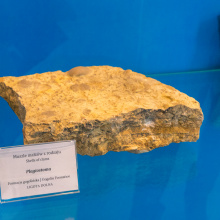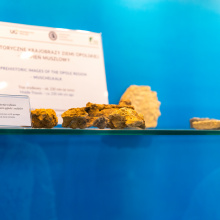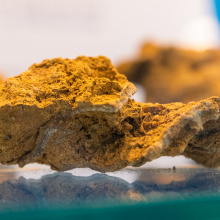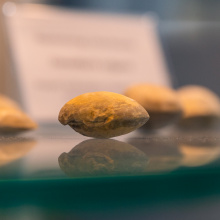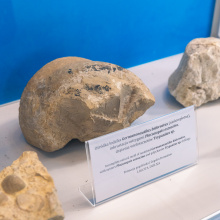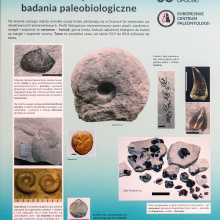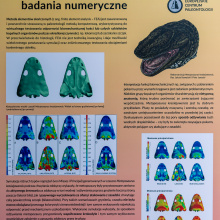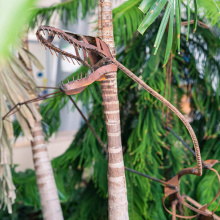Silesaurus - a genus of archosaur living in the late Triassic in modern Europe. Photo by dr Elżbieta Sontag.
Reconstructions of dinosauriform reptiles from 250 million years ago, fossils of ammonites or sea urchins, mussels and other animals of the seabed will be on display at the new exhibition of the Faculty of Biology, University of Gdańsk, entitled Prehistoric Landscapes of the Opole Area. The exhibition was created as part of broadening and promoting palaeontological research conducted at the Faculty of Biology of the University of Gdańsk.
The Prehistoric Landscapes of the Opole Area is a palaeontological exhibition prepared in cooperation with researchers from the European Centre of Palaeontology at Opole University, headed by dr hab. Elena Yazykova, prof. UO. Placed at three levels of the Faculty of Biology of the University of Gdańsk, the exposition is based on palaeontological findings discovered in the deposits of Upper Silesia.
The exhibition consists of 3 parts: A Sea of Keuper Claystone from the Middle Triassic (247-237 Ma), Large and Small Inhabitants of the Prehistoric Krasiejów from the Late Triassic (ca. 205-210 Ma) and the Cretaceous Sea of Opole (93.9-89.8 Ma).
- 'Here we will see above all a variety of organisms living in the age of dinosaurs, basically a whole cross-section of marine and land animals. Above all, these are organisms that tell us a lot about the evolution of life and how the environment changed throughout the Mesozoic, that is, the time of the dinosaurs,' - says mgr Błażej Bojarski from the Department of Invertebrate Zoology and Parasitology, Faculty of Biology, UG, who showed us around the exhibition.
The exhibition includes, among others:
- skulls and other skeletal fragments of shield-headed amphibians (Metoposaurus and Cyclotosaurus), which were up to 2-3 m long;
- models: a metoposaurus and a Polish dinosauriform - sileasaurus (Silesaurus opolensis) - which is particularly interesting as it was described by Polish researchers based on finds from Krasiejów, in free translation it is the 'Silesian lizard from Opole';
- fragments of the skeleton of Stagonolepis - a large reptile from the group of archosaurs, weighing about 200 kg;
- skeletal fragments of a marine reptile of the order Nothosauria;
- ammonites - extinct molluscs (Cephalopoda) related to modern cephalopods - octopods (octopodes, vampyromorphida) - the average of the largest known ammonite is 2.5 m;
- dozens of fossils of sea urchins, mussels, brachiopods and other animals of the sea bed.
The originator of the exhibition is prof. dr hab. Dariusz Szlachetko, Dean of the Faculty of Biology, University of Gdańsk.
- 'I have been thinking about organising an exhibition of ancient organisms at the Faculty of Biology for a long time. I think that it is worth bringing closer the stories of creatures which existed on Earth before the appearance of man and which were very different from those living today,' - says prof. dr hab. Dariusz Szlachetko. - 'The exhibition is accompanied by educational materials in the form of charts with descriptions of the exhibits themselves, their living conditions, the geological history of the Earth, changes in tectonic plates and climate, etc.'
The graphic design of the exhibition (including backgrounds, illustrations of animals, designs of boards, arrangement of niches etc.), as well as the substantive layout of individual periods, was prepared by mgr Anna Król from the Faculty of Biology, University of Gdańsk - an artist and computer graphic designer, who has been doing various projects for the Faculty since 2008.
The exhibits borrowed by the Biology Department come from excavations carried out in the Opole region. They were previously in the collections of the University of Opole and the Jurassic Park in Krasiejów.

